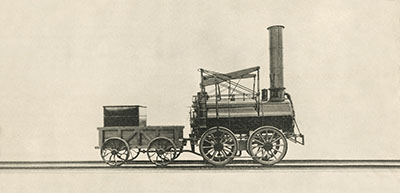

"A Century of Progress International Exposition" was the name given to the World's Fair held in Chicago, IL. It was originally scheduled to run only from 27th May until 12th November 1933, but was so successful that it opened again from 26th May to 31st October 1934. In those two years, the Exposition attracted 48,769,227 visitors.
This was the second world's fair Chicago had hosted (the first was the Columbian Exhibition in 1893), and was conceived at a time of economic recession, fears of political radicalism, race tensions and gangster violence. The central theme of the fair was the unity of science and industry, with the motto "Science Finds, Industry Applies, Man Conforms".
The buildings and exhibits drove home the message, celebrating industrial achievements and pointing to a bright future for the country. Nearly two dozen corporations erected pavilions and developed displays that insisted that Americans needed to spend and modernise everything from their houses to their cars. A number of railroads and their suppliers also mounted exhibits, displaying their most technologically advanced products, as well as participating in the "Wings of a Century" pageant, and this page concentrates solely on the railroads' presence at the fair.


Above, Bird's-eye View of the Exposition(Looking South), from Official World's Fair Pictures.
Below, two panoramic views of the fair grounds, also from Official World's Fair Pictures. Aerial and panoramic views like these were popular means of demonstrating the scale of the accomplishment in publications, magazine and newspaper features, and postcard views.


Above, a map of the fair grounds.
The pavilions, temples, restaurants, themed villages, outdoor displays, camps and play areas were spread over a four hundred and twenty-seven acre portion of Burnham Park on three and a half miles of newly reclaimed land between 12th and 39th streets along the shore of Lake Michigan.
Built on land owned by the state, not the city, the structures were free from the city's strict building codes, which allowed the architects to explore new materials and building techniques. The buildings were consequently modernistic in style in contrast to the neoclassical style that characterised those built for the World's Columbian Exposition.



Above, the modernist aesthetic, top-down, the Owens-Illinois Glass Building, the House of Tomorrow and North Court of the Hall of Science, all from Official World's Fair Pictures booklet.


The Travel and Transport Building, designed by E. H. Bennett, H. Burnham and J. A. Holabird, was generally considered the most outstanding example of modernist architecture on the site, and its popularity is demonstrated by the frequency of its appearances in promotional material, postcards and other memorabilia.
Topped by the earliest catenary roof constructed in the US, the main building's 200’ diameter 125’ high domed roof was suspended on cables attached to twelve 150’ high steel towers around the exterior. The dome enclosed what was described as the "largest unobstructed area beneath a roof" in the US.

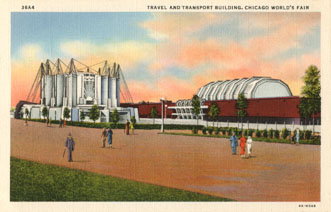

Vivid colours applied to the exteriors and interiors of buildings was another feature of the fair and, above, the Travel and Transport Building's wings appear to have been green, black and white at various times.
Electrical illumination of the fairgrounds and buildings at night was another spectacular feature of the fair, and the Transportation Building was no exception and, below, its special lighting made it look as though it was illuminated from within.
Bottom, one of the stereoscopic views of the grounds on sale featured the building at twilight.
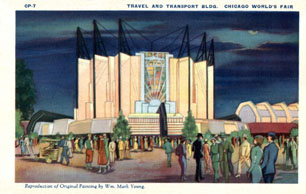





The building housed a number of other exhibits, including, top, an Amateur Radio Exhibit, W9USA, located on the second floor.
About 4,000 visitors from all over the world signed the registration book and more than 10,500 messages were received.

Right, the Waukesha Motor Company displayed its combustion engines in the Automotive section and United Airlines displayed a Boeing "Three-Mile-A-Minute" passenger aircraft.
Above, Standard Oil also exhibited "the romantic, colorful history of Petroleum and the part it has played in the great Industrial development the Century of Progress celebrates".
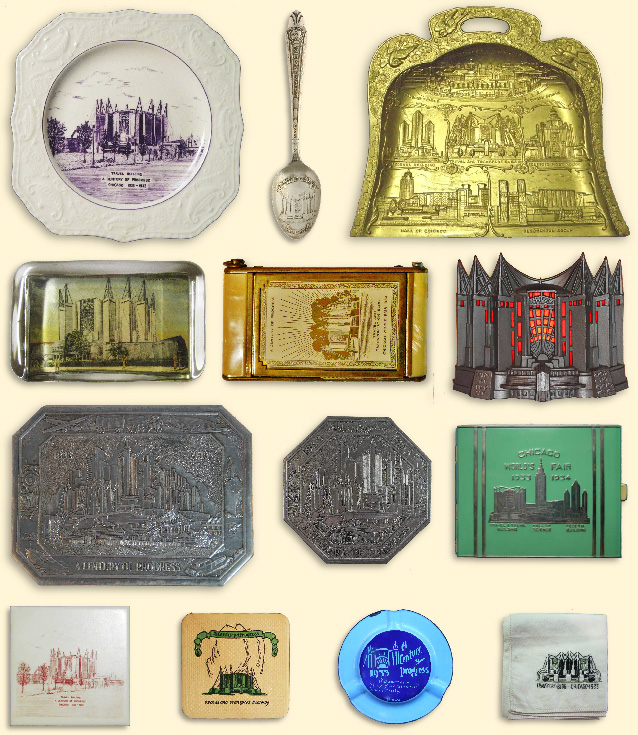
Above, a small sample of some of the objects that featured the building, from dinner plates, to cutlery, paperweights, night lights, trivets, tiles, coasters and ashtrays.


The "Wings of a Century, The Romance of Transportation", an open air pageant set to music was staged four times daily, telling the story of the country's progress in transportation side by side with its "hundred-year march from a small pioneer nation to a leader in world affairs". Two hundred performers appeared with seventy horses, seven wagons and ten trains.
The idea to stage the pageant came from Edward Hungerford, who had directed the Fair of the Iron Horse in Baltimore in 1927. Helen Tieken Geraghty, who had been
hired to direct the Enchanted Island Children's Theater at the fair, was then appointed to stage the show with Hungerford as consultant. He appears to have authored the accompanying 10c program booklet.
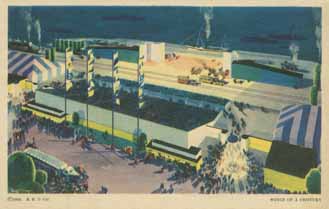
Above, a postcard view of the 175' long by 170' deep stage .
The front part consisted of a level road with sunken railroad tracks on which trains and vehicles crossed. Two wings behind the road were used to stage scenes involving people, animals and smaller vehicles. The rear part had another set of railroad tracks and a runway on which boats moved on trucks against the backdrop of Lake Michigan.


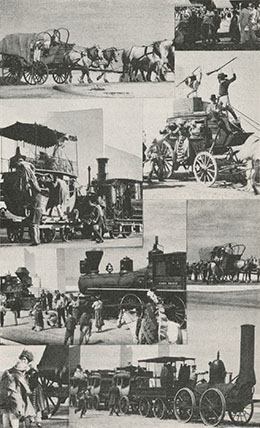
Above, the four locomotives from a page from the Official Guide Book, World's Fair 1934 are, upper left to lower right, Baltimore & Ohio "Thomas Jefferson", Central Pacific #1 "C. P. Huntington" standing in for the "Jupiter" at a re-enactment of the driving of the Golden Spike at Promontory, UT. Union Pacific #9 stands in for #119 to the right of #1. Bottom right, Delaware & Hudson "DeWitt Clinton".
You can see a short film of the pageant posted by Derek Dahlsad on YouTube.
Above, the pageant began with scenes of early European settlers displacing Native Americans from the land, progressing through scenes of water transport, railroads and motor vehicles to aircraft. Photos from Official World's Fair Pictures.

The Baltimore & Ohio Railroad was a major contributor of equipment, much of it having featured at the 1927 Fair of the Iron Horse.
Below, a replica of the the horse drawn "Pioneer".

The replica was built at the B&O's Mt. Clare workshops in 1892 for display at the 1893 World's Columbian Exposition in Chicago, IL. The original was built by Richard Imlay in Baltimore, MD, in 1829.
The “Pioneer” also ran at the 1927 Fair of the Iron Horse, the 1939-40 New York World's Fair and the 1948-49 Chicago Railroad Fair. You can see photos and find out more about the “Pioneer” on the Baltimore & Ohio Railroad Museum Roundhouse page of this website.

Above, the historic race with the "Tom Thumb", believed to have taken place on 28th August 1830. The "Tom Thumb" easily pulled away from the horse until the belt slipped off its blower pulley, it lost power and the horse won the race.

Above, the "Tom Thumb". This 0-4-0 is a replica built at B&O's Mt. Clare workshops in 1927 for the Fair of the Iron Horse. The original was built in 1830 by Peter Cooper as a demonstrator locomotive.
On 28th August 1830, it carried the B&O directors in a passenger car to Ellicott's Mills, to their amazement, travelling at the then impressive speed of 10-14 miles per hour. It was later dubbed "Tom Thumb" because of its small size and weight of less than a ton.
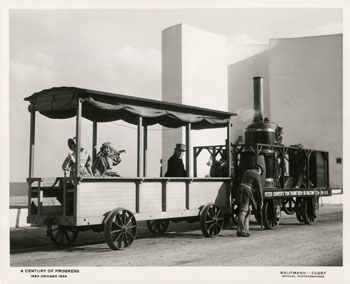
You can see photos and find out more about the "Tom Thumb" on the B&O Railroad Museum Roundhouse page of this website.
Left, the replica "York" was built at the B&O's Mt Clare shops in 1927 and steamed at the ">Fair of the Iron Horse.
The original 0-4-0 "York" built in 1831 by Davis & Gartner in York, PA, was the first locomotive to operate on the B&O Railroad.

The white coach behind the "York" in the photo above came from the Albion Mines Railway at Stellarton, Nova Scotia, Canada. It was not originally white but was perhaps painted that colour because of a legend that later arose that any unmarried lady who rode in the coach for twenty minutes without uttering a word would be a bride within the year. It hence became known as the "Bride's Coach" although there is no trace of such a legend having currency in the part of Nova Scotia where the coach was originally used.
The replica "York" has been preserved. You can find out more about it on the Chicago Museum of Science & Industry page of this website. You can see more photos of the coach on the B&O Railroad Museum Roundhouse page.

The engine above, appearing as the Baltimore & Ohio Railroad's "Atlantic" is actually the "Andrew Jackson" #7, built in 1836 by Ross Winans and George Gillingham. It was adapted at the B&O's Mount Clare shops in 1892 to resemble "Atlantic" #2 for the 1893 Columbian Exposition in Chicago, IL. The original "Atlantic" was built in 1832 by Phineas Davis and Israel Gartner of York, PA, after winning the competition to design a suitable locomotive for the line. It was scrapped in 1835.
This version of the “Atlantic” was also displayed at the 1927 Fair of the Iron Horse, the 1939-40 New York World's Fair and the 1948-49 Chicago Railroad Fair. You can see photos and find out more about it on the Baltimore & Ohio Railroad Museum Roundhouse page of this website.


Above, this "Grasshopper" type locomotive started life as the "John Hancock", built by George Gillingham and Ross Winans in 1836.
It worked at Mt. Clare until 1892 when it was retired and rebuilt for display at the 1893 World's Columbian Exposition in Chicago, IL. At that time, it was incorrectly named the "Thomas Jefferson", which had been the railroad’s first #3 "Grasshopper" locomotive.

The engine appeared at the 1927 Fair of the Iron Horse, the 1939-40 New York World's Fair and the 1948-49 Chicago Railroad Fair.
You can find out more about it on the Baltimore & Ohio Railroad Museum Roundhouse page of this website.

Above, parked just behind the "York" in the photo above, the replica of the 4-2-0 "Lafayette" was built at the Mt. Clare workshops in 1927 for the Fair of the Iron Horse at which it was also displayed, as the "William Galloway". William Galloway had driven the first, horse-drawn train from Mt Clare to Elllicott's Mills in 1830.
The original "Lafayette" was built by the Norris Locomotive Works in Philadelphia, PA, in 1837 and was the first horizontal boilered locomotive built for the railroad with the cylinders positioned at the side of the smokebox.
The replica also appeared at the 1939-40 New York World's Fair and the 1948-49 Chicago Railroad Fair. You can find out more about the replica "Lafayette" on the Baltimore & Ohio Railroad Museum Roundhouse page of this website.

Below, the "Memnon" is one of six 0-8-0 locomotives ordered by the B&O in 1848. Retired in 1892, it was rebuilt for display at the 1893 World's Columbian Exposition when it returned to #57. It last steamed at the 1927 Fair of the Iron Horse.
#57 was also displayed at the 1939-40 New York World's Fair and the 1948-49 Chicago Railroad Fair. You can see photos and find out more about the locomotive on the Baltimore & Ohio Railroad Museum Roundhouse page of this website.


Built by the Mason Machine Works in Taunton, MA, in 1856 as #25, the 4-4-0 above was named "William Mason" in 1927 in honour of its builder when it appeared at the Fair of the Iron Horse. It is one of the oldest surviving freight locomotives in the US.
#25 was also displayed at the 1939-40 New York World's Fair and the 1948-49 Chicago Railroad Fair. You can find out more about it on the B&O Railroad Museum Roundhouse page of this website.

Above, #117, built at the Mt. Clare shops in 1863 as #147, is a Ten Wheeler (4-6-0) type locomotive designed by the B&O Master of Machinery, Thatcher Perkins. It became #117 in 1892 and was named "Thatcher Perkins" for the 1927 Fair of the Iron Horse.
#117 was also displayed at the 1939-40 New York World's Fair and the 1948-49 Chicago Railroad Fair. You can find out more about it on the B&O Railroad Museum Roundhouse page of this website.

Above, the 4-6-0 camelback "Ross Winans" was built in 1869 at the Mt. Clare shops as #305. Retired in 1892, it featured at the 1893 World's Columbian Exhibition, the 1927 Fair of the Iron Horse , 1939-40 New York World's Fair and 1948-49 Chicago Railroad Fair. You can find out more about it on the B&O Railroad Museum Roundhouse page of this website.
Below, an I-15 class 2-6-6-2 articulated locomotive, #7450, is shown as scheduled to appear at the “Wings of a Century” pageant. This engine was built by the Baldwin Locomotive Works with a conventional stayed firebox to provide operational comparison to another 2-6-6-2 also built by Baldwin but with an Emerson watertube firebox Class KK-1 #7400. Both locomotives were built in 1930, and both were retired and scrapped in 1953.
As built, #7450 had a 92.3 sq ft grate and 436 sq ft firebox including 110 sq ft in the combustion chamber and 46 sq ft of arch tubes. With 1,689 sq ft of superheating, the total heating surface was 7,169 sq ft. It was later rebuilt with 18 sq ft of arch tubes and 95 sq ft of thermic syphons for a total firebox heating surface of 403 sq ft.
The engine wheelbase was 55’ 8” with a driver wheelbase of 12’ 2”. The overall wheelbase (engine and tender) was 104’ 5”. The engine weighed 466,000 lbs, 373,000 lbs on its 70” drivers. With Walschaert valve gear and four 23” x 30” cylinders, it operated at a boiler pressure of 250 psi delivering 96,354 lbs tractive effort. The tender weighed 273,000 lbs light with a capacity of 18,000 gallons of water and 20 tons of coal.


Above, B&O Class T-1 Mountain type (4-8-2) locomotive, #5510 was one of two built by Baldwin in 1930. It appeared at the fair in 1933 with a typical consist of the railroad's flagship passenger service, the Capitol Limited, which ran between New York City, NY, and Chicago, IL, Washington, DC,and Pittsburgh, PA. The consist included the Maryland observation car, the Illinois sleeping car and the Mary Pickersgill dining car.
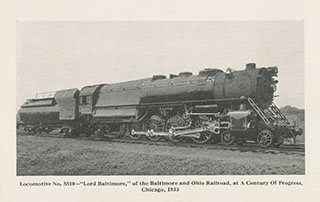
#5510 had a watertube firebox designed by B&O's General Superintendent of Motive Power & Equipment, George Emerson, whereas the second locomotive, Class T-2 #5550, had a conventional stayed firebox. Both locomotives had 74” drivers and
27½” x 30” cylinders and operated at a boiler pressure of 250 psi delivering 65,150 lbs tractive effort.
With a 92 sq ft grate, 866 sq ft firebox and 1,340 sq ft superheating, #5510 had a total heating surface of 6,743 sq ft and was 1,000 lbs heavier at 385,000 lbs.
The tender weighed 273,000 lbs light with an 18 ton coal and 18,000 gallon water capacity.
Although the Emerson firebox didn't offer much of an advantage over the conventional 4-8-2, both locomotives remained in service on the B&O into the 1950s.
Details of the consist accompanying #5510 were provided in the pamphlet above, The Air-Conditioned Train of the Baltimore and Ohio Railroad on the Exhibition Track Outside the Travel and Transport Building.


The sole B&O Class P-9, a Pacific type (4-6-2) locomotive built at the B&O’s Mt Clare workshop in 1929, #5320 the "President Cleveland" above appeared at the fair in 1934. It differed from the earlier B&O Pacifics in having Caprotti valve gear and a 503 sq ft watertube boiler. It had 80” drivers delivering 50,000 lbs tractive effort.
#5320 was the last of the B&O’s so-called “President” Class. The first twenty designated P-7 had been built by Baldwin in 1927, named and lettered after the first twenty presidents of the United States (#5300-#5319). In 1947, #5300 was rebuilt to conform to the others in the P-7 class.
You can see the first “President”, #5300, and find out more about the Class on the Baltimore & Ohio Railroad Museum Yard page of this website.
Inside the Travel and Transport Building, the B&O took the opportunity to re-use some of the exhibits it had displayed at the 1927 Fair of the Iron Horse.
The exhibits included, from the top-down below, dioramas of the railroad's crossings of the Potomac River in Harpers Ferry, MD, the City of Washington, DC, and the Meeting at George Brown's House in Baltimore, MD, on 12th February 1827 at which the railroad was founded
These images are from the Preliminary Pamphlet, the Baltimore and Ohio Railroad at a Century of Progress, Chicago 1933.





Above, Central Pacific #1, the “C. P. Huntington”, parading in the “Wings of a Century” pageant.
The locomotive was bought by the Central Pacific in 1863 as #3 from Danforth, Cooke & Co., in Patterson, NJ, and helped build the transcontinental railroad. It weighs 43,500 lbs, has 54” drivers and 11” x 15” cylinders. With a 9.39 sq ft grate and 58 sq ft firebox, total heating surface was 419 sq ft. A coal burner, it operated at a boiler pressure of 110 psi delivering 3,570 lbs tractive effort.
In 1871, the engine was transferred to the newly organised Southern Pacific Railroad and renumbered #1. After transfer, it operated as a light construction engine between San Jose and Hollister, CA, then in Oakland, before ending its career as a weed burner, clearing track. However, from 1894, #3 increasingly became a publicity symbol for the Southern Pacific Railroad, appearing at station openings and exhibitions, including the 1915 San Francisco Panama-Pacific Exposition and the 1969 Sacramento Gold Spike Centennial Celebration.
The “C. P. Huntington” has been preserved. You can see photos and learn more about it on the California State Railroad Museum page of this website. It is the only surviving example of a 4-2-4 locomotive in the US.

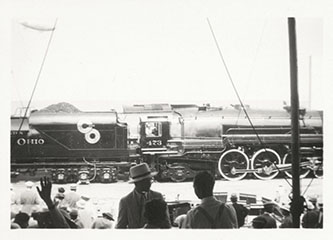
Above, Chesapeake & Ohio Class F-17A Pacific type (4-6-2) locomotive appears to have made an appearance in the "Wings of a Century" pageant.
Six F-17 locomotives were built at Alco's Richmond, VA, works in 1914 to work the challenging terrain between Charlottesville, VA, and Hinton, WV, hauling ten car passenger trains at an average speed of 25½ mph (#470-#473). In the mid 1930s, all six were overhauled by the C&O and reclassed as F-17A, increasing driver size from 69" to 74" and increasing the total heating surface and boiler pressure as well as tractive effort.
#473 weighed 334,320 lbs, 199,830 lbs on its drivers. The engine wheelbase was 35' 5" and the driver wheelbase 13'. With Walschaert valve gear and 27" x 28" cylinders, it had an 80.7 sq ft grate and 281 sq ft firebox including 27.4 sq ft of arch tubes, a Schmidt superheater, Ragonnet power reverse gear, Locomotive Stoker Company type C, Street mechanical stoker and Franklin pneumatic grate shaker. Total heating surface was 5,540 sq ft, including 991 sq ft superheating. Operating at a boiler pressure of 200 psi, it delivered 46,519 lbs tractive effort. The tender weighed 300,000 lbs light with a 20 ton coal and 16,000 gallon water capacity.

Above, Chesapeake & Ohio Railroad #490 steamed in the "Wings of a Century" pageant. It was the first of five F19 class Pacific type (4-6-2) locomotives built for the railroad at Alco's Richmond, VA, works in 1926 (#490-#494). They were the last Pacifics bought by the C&O. In 1930, #490 was assigned to the Sportsman, the new premier C&O passenger service bet5ween Newport News, VA, Washington, DC, and Detroit, MI. It was later assigned to the George Washington night sleeper passenger service on most of the route between Washington, DC, Newport News, VA, and Chicago, IL.
The F19s had a 13' driver wheelbase and an engine wheelbase of 36' 7". They weighed 331,500 lbs, 200,000 lbs on their 74" drivers. With a 80.3 sq ft grate, 281 sq ft firebox, total heating surface of 5,452 sq ft, including 1,213 sq ft superheating, they were equiped with Elesco feedwater heaters, Baker valve gear and 27" x 28" cylinders, flying airpumps (smokebox-mounted), deck-mounted headlights and roller bearings on the engine trucks. Operating at a boiler pressure 200 psi, they delivered 46,892 lbs tractive effort.
The engines entered service with 12,000 gallon, 15 ton coal Vanderbilt tenders carrying the large C&O logo on the coal bunker sides, but were later fitted with much larger tenders, weighing 347,000 lbs light, with a capacity of 28 tons of coal and 18,000 gallons of water.
Left, the F19s were rebuilt as L1 class Hudson (4-6-4) types at the C&O's Huntington, WV, workshops in 1946. Four (#490-#493) were fitted with yellow streamlining, which earned the rebuilt locomotives the somewhat unindearing nickname of "Yellowbellies".
You can see photos and find out more about the streamlined #490 on the Baltimore & Ohio Railroad Museum Yard page of this website.


Above, the C&NW displayed the 4-2-0 "Pioneer", built in 1837 by the Baldwin Locomotive Works in Philadelphia, PA for
the Utica & Schenectady Railroad, NY, as #4 and named "Alert". In 1846, it was sold to
the Michigan Central Railroad, who added a cab and tender. Two years later, it was sold to the Galena & Chicago Union Railroad, the oldest predecessor of what would become the Chicago & North Western Railway in 1859.
The locomotive was shipped to Chicago by schooner arriving on 10th October 1848 and hauled the first train westbound out of the city on 25th October. The G&CU renamed the locomotive "Pioneer" and used it in the construction work until 1850 when it was loaned to the Chicago, Burlington & Quincy Railroad for work in and around Chicago. At some point, it returned to the C&NW roster.
The "Pioneer" also appeared at the Chicago Railroad Fair in 1948-49, as well the Chicago Fair in 1950. It has been preserved in the collection of the Chicago History Museum in Chicago, IL. It was donated to the museum in 1972 and you can see photos and find out more about it on the CNW #4 page of this website.
At least three Chicago & Northwestern Class H Northern type (4-8-4) locomotives appear to have featured at the fair: top #3008, lower left #3010 and right #3024. Thirty-five of these dual purpose (freight and passenger) engines were built by the Baldwin Locomotive Works in 1929 (#3001-#3035). Because of their size, they were initially restricted to the railroad’s Chicago, IL-Omaha, NE, main line.
The H Class had an engine wheelbase of 48’ 7” and driver wheelbase of 20’ 6”. The engine weighed 498,000 lbs, 288,000 lbs on its 76” drivers. The main frame, including the cylinders, was a single steel casting 58’ 3” long and weighing 73,000 lb. With a Standard Type B (modified) stoker, a 100 sq ft grate, a 558 sq ft firebox with 129 sq ft of thermic syphons, 21 sq ft of firebrick tubes and a 116 sq ft combustion chamber, total heating surface, including 2,357 sq ft of superheating, was 7,571 sq ft. Operating at a boiler pressure of 250 psi with 27” x 32” cylinders, the H delivered 65,226 lbs tractive effort. As built, these engines also had a Franklin booster fitted to the engine's trailing truck that added another 11,300 lbs to starting tractive effort. The tender weighed 320,000 lbs light and had a capacity of 18,000 gallons of water and 20 tons of coal.
Twenty-four of the locomotives were rebuilt in 1946-1949 into class H-1 with internal frames, disc drivers and other improvements. Retirements started in 1950 and the last was scrapped in 1956. No H Class locomotives have survived.


The Chicago, Burlington & Quincy Railroad's equipment was exhibited on a set of 600’ long parallel tracks just south of the Travel and Transport Building.
The equipment was all open to the public.

In the photo above, the London, Midland & Scottish "Royal Scot" #6100 stands on the left. The British locomotive was only on display at the fair in 1933 passing through during a year long tour of the USA and Canada.
CB&Q S-4 #3000 is in the middle right and CB&Q #35 is on the far right. Just out of view, but evident in the top photo from the Official World's Fair Pictures booklet, is the CB&Q Zephyr.
Zephyr was the first of what would become one of the largest and most famous fleets of streamliners in the US.
Named by Burlington’s President Ralph Budd after Zephyrus, Greek god of the west wind, it was built entirely of welded stainless steel. Aeronautical engineer Albert Gardner Dean designed the sloping nose, with architect John Harbeson and industrial designer Paul Philippe Cret devising a way to strengthen and beautify the sides of the train.
At the time of its display at the fair, CB&Q class S-4 #3000 was the most powerful Hudson type (4-6-4) locomotive in the world.
The CB&Q ordered twelve of these locomotives from the Baldwin Locomotive Works in Philadelphia, PA, in 1930 (#3000-#3011). They were designed for fast passenger trains and went into service pulling CB&Q "varnish" passenger services such as the Ak-Sar-Ben between Lincoln, NE, and Chicago, IL (Ak-Sar-Ben is "Nebraska" spelt backwards), the Chicago, IL-Denver, CO, Aristocrat and the Black Hawk overnight Chicago, IL–Minneapolis/Saint Paul, MN, service.
The S-4 was one of the most successful steam locomotives operated by the CB&Q. They eliminated the need to swap one locomotive for another on long trips, and they were also fast: one is credited with hauling ten standard passenger cars between Cochrane and La Crosse, WI, at 112 mph.
#3000 was sold for scrap in 1955, but five other S-4s have survived. You can find out more about the class and see #3001 on the CBQ S-4 #3001 page of this website, #3007 on the Illinois Railway Museum Yard page, #3003 on the CBQ S-4 #3003 page and #3006 on the CBQ S-4 #3006 page.

Zephyr was equipped with an 8-cylinder,
8-201-A model Winton engine developing 600 hp at 750 rpm. Its three cars rode on four roller-bearing trucks, forming a permanently articulated 197' long trainset weighing 193,000 lbs.
Zephyr was built by the Budd Company in Philadelphia, PA, and was outshopped on 9th April 1934 to much acclaim. The train was christened on 18th April 1934 at the Pennsylvania Railroad's Broad Street Station in Philadelphia, PA. On 26th May that year, it completed a record breaking, 1,015 mile, thirteen hour five minute non-stop "Dawn-to-Dusk Dash" from Denver, CO, to Chicago, IL, arriving on stage at that year's inaugural "Wings of a Century" transportation pageant.

Above, passengers on the platform in Chicago after the "Dawn-to-Dusk Dash" run included "Zeph" the burro. Zephyr was renamed the Pioneer Zephyr in 1936 to distinguish it as the first of the CB&Q's growing fleet of Zephyrs, and made another appearance in the "Wheels A-Rolling" pageant at the Chicago Railroad Fair in 1948 and 1949.
The Pioneer Zephyr has been preserved, and you can see photos and find out more about it on the Chicago Museum of Science & Industry page of this website.

Below, a postcard view looking north between #35 and #3000. The Travel and Transport Building is straight ahead


#35 is an American type (4-4-0) locomotive built at the Burlington’s Aurora, IL, shops in 1892 as Hannibal & St. Joseph Railroad #66. In 1898, it was renumbered #666 and then became CB&Q #359 when the H&StJ was incorporated into the CBQ in 1904.
The locomotive was rebuilt in Denver, CO,in June 1932 for exhibition at the fair as Burlington & Missouri River Railroad #35. It also appeared later at the 1939-1940 New York World’s Fair, where it stood in for Union Pacific #119 at the re-enactment of the driving of the Golden Spike at Promontory, UT.

#35 has been preserved at the Patee House Museum in St. Joseph, MO. You find out more about it on the CBQ #35 page of this website.

On the track behind #35 was a replica of Hannibal & St. Joseph Railroad #1, the first railroad car in which US Mail was sorted in transit. The original was a refurbished passenger car.
The first experiment in distributing mails in so-called "post offices on wheels" was made in 1862 by William A. Davis between Hannibal and St. Joseph, MO. It was intended to speed connections at St. Joseph with the overland stage, which had replaced the Pony Express routes to the West a year earlier, by sorting the mail en route.


Above, Chicago, Rock Island & Pacific Railroad #5000, is a Class R65a Northern type
(4-8-4) locomotive that took part in the "Wings of a Century" pageant at the fair.
The first 4-8-4 was built at Alco's Schenectady, NY, works in 1927 for the Northern Pacific Railroad, from which the type took its name. To test the type on its railroad, the Rock Island bought one of the type from Alco's Schenectady, NY, Works in 1929. Classified R-67a, #5000 started working on the route from Silvis, IL, to Kansas City, MO, and performed so well that the railroad bought twenty-four more (Class R-67b) before the year ended (#5001-#5024).
The engine wheelbase was 45’ 7” and the driver wheelbase 19’ 3”. Weighing 434,000 lbs, 265,500 lbs on their 69” drivers, these were the largest Northerns to be rostered on a US railroad and their size and weight apparently limited their range to the Rock Island's Chicago, IL-Des Moines, IA, corridor, the Chicago, IL-Dalhart, TX, line and the segment between Herington, KS, and El Reno, OK. Later strengthening of bridges allowed them to haul freight and passenger trains to Denver, CO, Fort Worth, TX, Tucumcari, TX, and Minneapolis, MN. All of the class were rebuilt with 74" drivers by 1944.
#5000 was equipped with a Chambers front end throttle, Coffin feedwater heater, Baker valve gear, roller bearings on all axles and Boxpok drivers. It had 26” x 32” cylinders. With an 88.3 sq ft grate, the 505 sq ft firebox heating surface included 150 sq ft of thermic syphons. The total heating surface of 7,686 sq ft included 2,243 sq ft superheating. Operating at a boiler pressure of 250 psi it delivered 66,620 lbs tractive effort. The tender weighed 304,300 lbs light and had a capacity of 15,000 gallons of water and 20 tons of
coal.
In 1930, forty more R-67bs were purchased from Alco (#5025-#5064). In 1944, the railroad took delivery of ten more (#5100-#5109) and, in 1946, ten more (#5110-#5119). These twenty locomotives had 74" drivers, 26" x 32" cylinders, operated at a boiler pressure of 270 psi, weighed 474,500 lbs and delivered tractive effort of 67,088 pounds. The Rock Island Northerns are considered by many to have been amongst the most handsome of any 4-8-4 locomotives built in the US and the railroad's fleet was second in size to the Canadian National Railroad in North America and third to the USSR in the world. Sadly, none of the ROCK 4-8-4s has survived.

This gasoline powered passenger vehicle was designed by Alfred Williams, Chief Engineer for the Clark Equipment Company and built at the company’s shop in Battle Creek, MI. The company specialised in building forklifts, tractors and other industrial and construction machinery.
The Autotram body was aluminium with the 16 cylinder
engine mounted in rubber in the forward compartment. It was equipped with modern conveniences, including kitchenette luncheon service and was represented as capable of
reaching 100 mph. It was promoted as a less costly
alternative to a fully crewed passenger train. Offered in 42 seat and 72 seat models, it appears never to have gone into production.
Left, fair goers queue to inspect the interior of the AutoTram.
Nothing is known about what happened to the Autotram, which may have been scrapped during WWII. You can see a British Pathe News short showing it in action on YouTube.


Above, #1403 was built in the Delaware & Hudson's Colonie, NY, Shops in April 1933, fourth and last in a series of high-pressure engines that were the brainchild of the railroad's President, Leonor F. Loree, whose name the locomotive bore. While the earlier engines (#1400-#1402) were 2-8-0s, #1403 was a 4-8-0 type.
The engine weighed 382,000 lbs, 313,000 lbs on its 63” drivers.
The tender had a 14,000 gallon water and 17½ ton coal capacity weighing 287,000 lbs fully loaded. Fitted with a six wheel Bethlehem booster on the rear truck to provide extra effort at start up, a total of 108,000 lbs tractive effort was produced with all four cylinders using fresh steam and the tender booster, equivalent to that produced by contemporary mallets.
It had four cylinders. One (20” x 30”) high pressure cylinder was mounted in the frame just behind the firebox on the right side
and one (27½” x 32”) medium pressure cylinder on the left.
The two low (33” x 32”) pressure cylinders were located at the front of the frame under the smokebox.
Dabeg rotary cam poppet valves were driven from a gear suspended at the center of the main driver. With a 75.8 sq ft grate and 965 sq ft firebox, total heating surface was 4,427 sq ft including 1,076 sq ft superheating. The combination water-tube and fire-tube boiler operated at 500 psi, and overfire jets on the firebox supplied extra air for more complete fuel combustion.
#1403 was essentially a low speed freight hauler, suited to the needs of the D&, whose main business was coal. However, it was a maintenance hog, and soon passed out of favour. None of the three experimental locomotives survived.

Above, Delaware & Hudson #653 was part of the railroad's program of experimentation with steam locomotive design during the late 1920s and early 1930s, the Delaware & Hudson rebuilt two class P Pacific type (4-6-2) locomotives, including #653, with Dabeg poppet valve gear at the railroad’s Colonie, NY, shops in 1929. A third was rebuilt but with standard piston valves. The new locomotives were designated P-1 class. The original ten P class Pacifics were delivered to the D&H from Alco's Schenectady, NY, works in 1914.
The P-1s had a 13' 6" driver wheelbase and engine wheelbase of 35' 6", weighing 300,000 lbs, 191,000 lbs on their 73" drivers. The cylinders were 22" x 28". Their 320 sq ft, Wootten-type, firebox with a 86.94 sq ft grate was designed to burn anthracite coal. Total heating surface was 4,703 sq ft including 1,495 sq ft superheating. #653 operated at a much higher boiler pressure than the P class, 325 psi instead of 260 psi. It delivered 64,000 lbs tractive effort, nearly 50% more than the P class's 41,027 lbs. The tender weighed 160,500 lbs light and had a capacity of 14 tons of coal and 11,000 gallons of water.
#653 appeared at the New York World's Fair in 1939-40. The seven unmodified P class locomotives were quite successful working nearly forty years until they were scrapped in 1952-53. None of the three P-1 locomotives has survived.
The original
"Stourbridge Lion" was the first steam locomotive to run on a commercial railroad in the US.
It was built by Foster, Rastrick and Company
in Stourbridge, England for the the Delaware & Hudson Canal Company, a precursor to the D&H.
It was intended to work the new railroad line between Honesdale and Seely's Mills, PA.
However, it was destined to make only one round trip on on the line on 8th August 1829 before
being removed from service.
It had been ordered at three tons but was delivered at almost seven tons, proving too heavy for the strap-iron track that had been laid on the line. The locomotive never ran on the Delaware & Hudson again. Its boiler was subsequently used as a stationary power source and the locomotive was gradually stripped of its parts. It was displayed at the 1883 Railway Exposition in Chicago, IL, where souvenir hunters made off with whatever removable parts remained.
In preparation for the 1933 Chicago World's Fair, the Delaware & Hudson built a replica of the Lion in its Colonie, NY, shops. The replica was an anthracite-fuelled operating model, which also appeared at the 1939-40 New York World’s Fair and the Chicago Railroad Fair in 1948-49.
You can see what remains of the original Stourbridge Lion on the Baltimore & Ohio Railroad Museum Roundhouse page of this website, and the replica itself on the Stourbridge Lion page.

Below, is one of fifty Berkshire type (2-8-4) locomotives built for the Illinois Central by the Lima Locomotive Works in 1926 (#7000-#7049). The first forty engines, including #7008, were equipped with Elesco feedwater heaters, the remainder with Worthingtons. Valve motion had limited cutoff, piston valves measured 14" (356 mm) in diameter. The first 2-8-4 was built as demonstrator #1 by Lima in 1924 and then sold to the IC where it was renumbered #7050.
Above, #2412 is a Class 2400 Mountain type
(4-8-2) locomotive built for the Illinois Central at Alco’s Schenectady, NY, works in 1923. IC Class 2400 #2411 and the slightly heavier IC Class 2415 #2434, may also have appeared at the fair at different times.
The fifteen 2400 Class (#2400-#2414) engines were the first 4-8-2s bought by the IC. Over the next twenty years, it acquired another fifty-six and took boilers from its 2900 class 2-10-2 engines to build fifty-six 2500 class Mountains in its Paducah, KY, workshops, as well as another twenty class 2600.
With a 42’ 3” engine wheelbase and 19’ 6” driver wheelbase, #2412 weighed 362,500 lbs, 243,500 lbs on its 73½” drivers. It had Walschaert valve gear and 28” x 28” cylinders. The grate was 74.5 sq ft, the firebox 384.7 sq ft and the total heating surface was 5,870 sq ft, including 1,227 sq ft superheating. Operating at a boiler pressure of 225 psi, it delivered 57,120 lbs tractive effort. The tender weighed 191,500 lbs light with a 10,000 gallon water and 18 ton coal capacity.
None of the 2400 Class has been preserved (#2412 was scrapped in 1957) and only two of the 2500s have survived. You can see photos and find out more about them on the IC #2500 and IC #2542 pages of this website.
Originally numbered #213, the 2-4-4T (Tank) locomotive below was one of a large fleet of this type acquired by the Illinois Central for short haul commuter traffic in the Chicago area. Built in 1880 by the Rogers Locomotive Works in Paterson, NJ (later part of Alco), It was renumbered #201 in 1890 and hauled thousands of passengers to the 1893 Columbian Exposition in Chicago.
In 1900, it was renumbered #1401. Returned to #201 probably some time during the Chicago World's Fair, the locomotive later also appeared at the Chicago Railroad Fair in 1948/49.
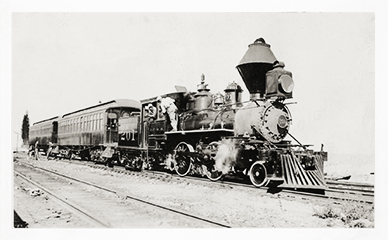
#201 has been preserved and you can see photos and find out more about the locomotive on the Illinois Railway Museum Train Shed page of this website.
The A-1s were equipped with Baker valve gear and 28” x 30” cylinders. With a 41’ 8” engine wheelbase and driver wheelbase of 16’ 6”, they weighed 388,000 lbs, 248,000 lbs on their 63” drivers. The grate was 100 sq ft, the firebox 414 sq ft, and total heating surface was 7,275 sq ft, including 2,111 sq ft superheating. Operating at a boiler pressure of 240 psi, they delivered 76,160 lbs tractive effort. The tender weighed 286,000 lbs light with a capacity of 15,000 gallons of water and 20 tons of coal.
The A-1s apparently did not ride well above 40 mph, and the trailing truck tended to derail when reversing. A rebuild at the railroad’s Paducah, KY, works in 1939 made significant changes to the engines, increasing boiler pressure to 265 psi and tractive effort to 78,194 lbs.

Above, the "Mississippi" is the only survivor of the Natchez & Hamburg Railroad, built to connect the river port at Natchez with the interior of the state of Mississippi.
A wood burner built in 1836 by H. R. Dunham & Co., in New York, NY, it operated for only a few years from April 1837 until May 1840 when a violent storm destroyed much of the railroad's property and contributed to its failure. The locomotive went into storage until it was sold to the Grand Gulf & Port Gibson Railroad in 1844.
Transferred to the Mississippi Valley & Ship Island Railroad in 1873, after an accident a few years later, it was salvaged by James Hoskins of Brookhaven, MS, in 1880, who reconditioned the locomotive and put it to work on his railroad, the Meridian, Brookhaven & Natchez. In 1891, he donated it to the Illinois Central for Chicago's Columbian Exposition in 1893 and it actually ran under its own power the eight hundred miles to Chicago.
The IC donated the "Mississippi" to the Museum of Science & Industry in 1938. You can find out more about it on the Museum of Science & Industry page of this website.

The locomotive was dismantled and shipped in pieces from Tilbury Docks on the Canadian Pacific Steamship, the SS Beaverdale along with its driver, engineer and fireman. The then world's largest floating crane, 'London Mammoth', was used to place the engine on the steamship (Quarkman0 has uploaded a short video to YouTube of #6100 being loaded at Tilbury). It was then put back together on arrival in Chicago, IL. The shipping cost and operating costs while the engine was overseas were met by the LM&S.
An eight car consist accompanied #6100 on the trip, consisting of a third-class corridor type, a third-class vestibule coach, an electric kitchen car, a first-class corridor vestibule coach, a lounge car, a third-class sleeping car, a first-class sleeping car and a first-class corridor car.
The London, Midland & Scottish Railway "Royal Scot" #6100, is a Ten Wheeler type (4-6-0) built at the North British Locomotive Works in Derby in 1930 as #6152. It was partly rebuilt and renumbered #6100 for its trip to the US and Canada and retained that number for the rest of its life.
#6100 has 81” drivers and three 18” x 26” cylinders. A coal burner operating at a boiler pressure of 250 psi, it delivered 33,150 lbs tractive effort. US railroad regulations required it be fitted with a cowcatcher, head lamp on the top of the smokebox and a bell above the front bufferbeam.

In October 1933, the "Royal Scot" left the fair for a post-exhibition tour, initially west to California, then up the Pacific coast to Vancouver and east through Canada to Montreal from where it was shipped back to England. It was operated by an English crew accompanied by local crews along the way and more than 3,000,000 spectators saw #6100 on the trip.
#61000 was retired in 1962. It is now owned by the Royal Scot Locomotive and General Trust and is stabled at the LNWR Heritage workshops in Crewe.

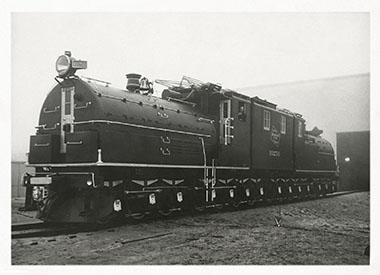
Above, Milwaukee Road EP-2 #10250 is one of five electric locomotives (#10250–#10254) built in 1919 at a cost $200,000 each by General Electric at its Schenectady, NY, works. They were designed for passenger service on the six hundred and fifty-sixty miles of newly electrified line on the railroad's newly electrified Coast Division in Montana.
The five units realised immediate savings over steam locomotives, running long distances without requiring servicing and hauling trains up grades that had required double-headed steam engines. Their distinctively modern design also made them the most famous of MILW's electric locomotives. They operated from 1919 until 1957 and came to symbolise The Olympian, the railroad's premier passenger service between Chicago and Seattle. They were renumbered #E-1-#E-5 in March 1939. #E-3 appeared at the Chicago Railroad Fair in 1948-49. From 1953, the EP-2s saw less and less use. In 1957, they transferred to the Mountain Division but mounting operational problems led to their retirement in 1960.
Only one EP-2 has survived, #10251 renumbered #E-2. You can see photos of it on the National Museum of Transportation, St. Louis Yard page of this website.



Above, the "General" is an American type (0-4-0) locomotive built in 1855 by Rogers, Ketchum & Grosvenor in Paterson, NJ (later part of Alco) to the Western & Atlantic's 5' gauge. It is one of the locomotives involved in what has come to be known as the "Great Locomotive Chase".
The "General" appeared at the 1939-40 New York World’s Fair and the 1948-49 Chicago Railroad Fair. You can see photos of the locomotive and find out more about it and the "Great Locomotive Chase" on the Southern Museum and Great Locomotive Chase page of this website.

Below, the New York Central unveiled this 4-4-0 American type locomotive, #999, in 1893 for display at the World's Columbian Exposition in Chicago, IL. It was built at the railroad's West Albany, NY, shops for $13,000 and entered service on 9th May 1893, hauling the "Empire Express" from Syracuse, NY, to Chicago, IL.
By the 1920s, it had been moved to the general passenger pool with all the other NYC 4-4-0s. It appeared at the 1939-40 New York World’s Fair.
Built at Alco’s Schenectady, NY, works, the Hudson type (4-6-4) locomotive above, #5297, was one of the first of the type delivered to the New York Central Railroad in 1927 and one of the first built in the US.
The Hudson type was designed for the NYC where it was named by the railroad’s President Patrick E. Crowley after the Hudson River, which was visible from his office window. Development was spurred by the increase in passenger business, which could not be met by existing NYC Pacific type (2-6-4) motive power. The four wheel trailing truck that allowed a much larger firebox with much greater steaming power.
The new design was so successful that two hundred and seventy-five more were acquired by the NYC and its subsidiaries from 1927 to 1938, built mainly by Alco. The NYC numbered them consecutively including those on its subsidiary lines, starting at #5200 in an unbroken string to #5474. Built for speed but not good starters, all two hundred and seventy-five were fitted with boosters on their trailing trucks.
With an engine wheelbase of 40’ 4” and driver wheelbase of 14’, the Hudsons weighed 359,800 lbs, 189,000 lbs on their 79” drivers. The grate was 81.5 sq ft and the firebox 281 sq ft. Total heating surface was 6,435 sq ft, including 1,951 sq ft superheating. Fitted with Coffin feedwater heaters, Walschaert valve gear and 25” x 28” cylinders, they operated at a boiler pressure of 225 psi delivering 42,366 lbs tractive effort. The tender weighed 316,400 lbs light with a capacity of 12,500 gallons of water and 24 tons of coal.
None of the NYC Hudsons has survived.

Above, #2998 is New York Central Class L-2d Mountain (4-8-2) type locomotive, although known as a Mohawk on the NYC. These were dual purpose locomotives, fifty of which were built at Alco's Schenectady, NY, shops in 1929. Ten years later, #2998 and L-2d #2995 were rebuilt exclusively for passenger service with slightly smaller diameter cylinders, increased boiler pressure and a few extra sq ft of superheating.
Only one L-2d has survived, #2933. You can see photos and find out more about locomotive and more about the class on the National Museum of Transportation, St. Louis Yard page of this website.


It also appeared at the 1948-49 Chicago Railroad Fair. You can see it on the Chicago Museum of Science and Industry page of this website.


Above, the "DeWitt Clinton" is a replica built in 1893 by the New York Central for that year's Columbian Exposition held in Chicago, IL. The original was designed by John B. Jervis and built by David Matthew at the West Point Foundry for the Mohawk & Hudson in 1831, was the railroad's first locomotive. The M&H was absorbed into the NYC in 1853.
The replica was exhibited at the Fair of the Iron Horse in 1927, the 1939-40 New York World’s Fair and the 1948-49 Chicago Railroad Fair. The replica has been preserved. You can see photos and find out more about it on the Henry Ford Museum page of this website.


The Class A-2 Northerns (4-8-4) were the Northern Pacific's first roller bearing locomotives (#2650-#2659). The first of these, #2650 above, was rushed from Baldwin's Eddystone plant in 1934 to take part in the grand finale the "Wings of a Century" pageant. Instead of crossing the stage like the other locomotives, however, #2650 halted in the center of the stage as the last word in passenger motive power.
Built with a cast-steel locomotive bed with integral
28" x 31" cylinders, they weighed 489,400 lbs, 294,00
lbs on their 77" drivers. With a 115 sq ft grate and 512
sq ft firebox, they operated at a boiler pressure of 250 psi delivering 67,073 lbs tractive effort. With the coming of later NP Northerns, the A-2s ended their careers hauling fast freights. None has survived.

Class Z-5 #5000, above, was the first of the Yellowstone (2-8-8-4) type locomotives built in the US. Outshopped for the Northern Pacific Railroad by Alco's Schenectady, NY, works in 1928, ten more were built by Baldwin the same year. They took the name from Yellowstone Park, one the best known destinations served by the railroad.
With an engine wheelbase of 66’ 8” and driver wheelbase of 16’ 9”, they weighed 723,400 lbs, 558,900 lbs on the 63” drivers. They were equiped with Walschaert valve gear, four 26” x 32” cylinders, an Alco Type G power reverse gear and Coffin feedwater heater. Total heating surface was 10,892 sq ft, including 3,219 sq ft superheating.
The grate was 182 sq ft. Three Nicholson thermic syphons in the 872 sq ft firebox and two in the combustion chamber added 256 sq ft to the heating surface. They operated at a boiler pressure of 250 psi delivering 145,930 lbs tractive effort. The tender weighed 402,000 lbs light and had a 21,200 gallon water and 28 tons coal capacity.
#5008 also appeared at the fair. None of the NP Yellowstones has survived.

Above, Northern Pacific #1, the "Minnetonka", an 0-4-0T (Tank) locomotive, was built by Smith & Porter of Pittsburgh, PA, in 1870 at a cost of $6,000, and was the first locomotive owned by the railroad. It helped during construction the east end of the Northern Pacific
system from Carlton to Brainerd, MN, then transferred to work on the west end from Kaloma to Tacoma, WA.
A wood burner, it is 17½' long and weighs 28,270 lbs. With 44" drivers and 10" x 16" cylinders, it operated at a boiler pressure of 125 psi delivering 3,330 lbs tractive effort.
After several different owners, #1 was reacquired by the NP in 1993. The "Minnetonka" also appeared at the 1939-40 New York World’s Fair and the 1948-49 Chicago Railroad Fair. It has been preserved, and you can see photos and find out more about it on the Lake Superior Railroad Museum page of this website.

Left, Pennsylvania Railroad Class M1a #6785 is a Mountain (4-8-2) type locomotive. In 1930, twenty-five of the class were ordered from Lima, fifty from Baldwin and twenty-five were built at Altoona, PA, by the Pennsy. #6785 was one of the Lima locomotives.
The prototype for the M1 class was built by the Pennsylvania Railroad at its Altoona, PA, works in 1923. Improvements in the M1a included the use of table grates, a six-spoke star nozzle in the smokebox and Worthington feedwater heater.
Above and right, M1a #6795, also built by Lima.
Another improvement on the M1 was a six-spoke star nozzle in the smokebox that improved draft, generated a smoother steam flow and produced cleaner exhaust. The addition of a Worthington feedwater heater raised boiler efficiency at the relatively minor cost of a 9" longer engine wheelbase (41’ 9”) and 5,000 lbs added weight to 390,000 lbs., 271,000 lbs on its 72” drivers.
With the M1a's 69.9 sq ft grate, 397 sq ft firebox with 29 sq ft of arch tubes, total heating surface, including 1,630 sq ft superheating, was 6,332 sq ft. With 27” x 30” cylinders, it operated at a boiler pressure of 250 psi delivering 64,547 lbs tractive effort. The large, six axle P75/F75 "coast-to-coast" tender weighed 378,360 lbs light with a 22,020 gallon water and 31½ ton coal capacity.

None of the M1a engines survived, but thirty-eight of the class were later converted to class M1b. Only of one of these, #6755, has survived. You can see photos of it on the Pennsylvania Railroad Museum Yard page of this website. It is the only surviving Pennsy Mountain type locomotive.
Below, this replica of the "John Stevens" was built at the Pennsylvania Railroad’s Altoona, PA, shops in 1932.
The first railroad charter in the US was granted to the New Jersey lawyer, engineer and inventor John Stevens and others in 1815 for the United New Jersey Railroad and Canal Company, later part of the Pennsy. He built the original steam carriage in 1825 and ran it on his Hoboken, NJ, estate hauling several passenger cars at a time at 12 mph.
On the right of the postcard above showing the interior of the Travel and Transport Building is the Camden & Amboy "John Bull".
This engine was shipped in parts to Philadelphia in 1831 from the United Kingdom, where it was built by Robert Stephenson & Co., in Newcastle. The parts were then shipped to Bordentown, NJ, where it was assembled for the engineer Robert L. Stevens after whom it was then named, although crews soon began calling it "the old John Bull", a reference to the personification of England under that name. Eventually, this was shortened to "John Bull".
This was the last time the original "John Bull" appeared at a railroad fair. It returned to the Smithsonian where it has remained on static display, except for a single outing under steam on 15th September 1981.
In 1939, an operable replica of the locomotive was built at the PRR's Altoona, PA, workshops which steamed at the 1939-40 New York World’s Fair and the 1948-49 Chicago Railroad Fair. You can find out more about the original "John Bull" on the Smithsonian Institute page of this website and the replica locomotive on the Pennsylvania Railroad Museum Train Shed page.

Stevens' "Steam Waggon" as he termed it, was arguably the first steam locomotive to operate on a track in the US, and the first with horizontal cylinders.
With 5" x 12" cylinders and 57" drivers, the replica operated at a boiler pressure of 100 lbs. It has survived and you can find out more about it on the Chicago Museum of Science and Industry page of this website. Another replica was built at Altoona in 1939 for the 1939-40 New York World's Fair. You find out more about that replica on the Pennsylvania Railroad Museum Shed page.
Above, the "Pioneer" was built in 1851 by the Union Works in South Boston, MA, and bought by the Cumberland Valley Rail Road. It operated over the CVR until retired in 1901.
A 2-2-2 type, "Pioneer" has no separate tender, so it is officially a tank engine. A wood burner weighing 25,000 lbs, it is built of wrought iron and cast iron, with copper boiler tubes, and has 54" drivers and 8½" x 14" cylinders. It hauled small, 1-3 car passenger trains between Harrisburg and Hagerstown, MD. During the Civil War, the CVRR provided an important supply line carrying Union materiel and troops to southern Pennsylvania, Western Maryland and northern Virginia, and the "pioneer" continued to operate over the railroad until retired in 1901.
From 1901, "Pioneer" appeared at many exhibitions, including the 1904 Louisiana Purchase Exposition in St. Louis, MO, and the 1948-49 Chicago Railroad Fair.
In 1961, the Pennsylvania Railroad , which had taken over the CVRR in 1919, donated "Pioneer" to the Smithsonian. It is on loan to Baltimore & Ohio Railroad Museum in Baltimore, MD, and you can see photos and find out more about it on the Baltimore & Ohio Railroad Museum Roundhouse page of this website.


The train then embarked on a twelve week nationwide tour until late 1934, including two months spent at the fair, by the end of which, it had covered 13,000 miles on fourteen different railroads in twenty-two states, making dozens of stops.
Over the course of the tour, it was seen by nearly one million visitors.
Above, in May 1934, the Union Pacific Railroad exhibited the M-10000 at the fair. It was delivered to the railroad on 12th February 1934 at a cost of $230,997 and was the first streamlined diesel train built in the US, beating the Burlington Zephyr by two months.
With its bubble shaped car body, waterfall front grille and tapered rear car, the three-car aluminium-clad train was liveried in high-gloss Armour Yellow with red lines separating the Leaf Brown
roof and undersides. At its February debut, the UP issued a souvenir coin made from the same aluminium used on the train's exterior.

M-1000 started service on 31st January 1935 as The Streamliner, the name changed to City of Salina in March that year when assigned to the daily Salina, KS-Kansas City, MO, return run.
After 900,000 miles in service, M-1000 retired on 16th December 1941. On 13th February 1942, it was sold and scrapped and its aluminium content contributed to the WWII arms effort.

Above, Union Pacific 4-4-0 #9 rolling through the "Wings of a Century" pageant.
I haven't been able to find anything about this locomotive. The original UP #9 was built as US Military Railroad "Osceola" in 1862 and went to the Union Pacific four years later as #9. It was renumbered #300 in 1885 and then sold or leased to the Kearney & Black Hills Railway and renumbered #1 in 1890. Four years later, the story ends: the engine was apparently condemned at Kearney in 1894. So, what is this #9?
Below, a rare photograph of #9, taken in the back lot of the fair.















